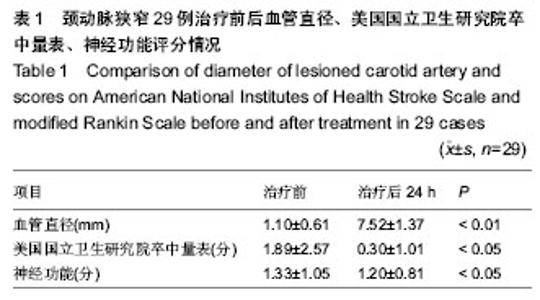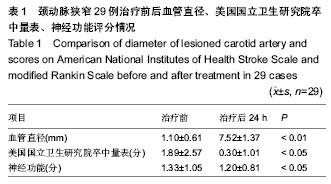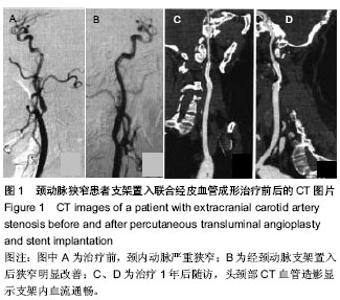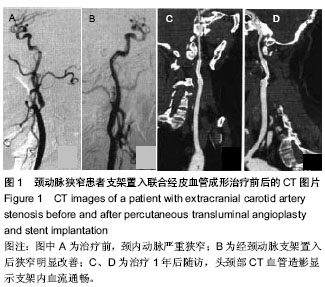| [1] 段鸿洲,李良,张扬,等. 颈动脉狭窄合并冠心病的分期介入治疗及随访研究[J].中国介入心脏病学杂志,2012,20(6):307-311.
[2] 杜会山,耿晓坤,刘建国,等.颈动脉经皮血管内成形及支架置入术预防非干预脑动脉系统卒中效果[J].临床误诊误治, 2012,25(8): 59-63.
[3] 万跃,彭小祥,刘艳霞,等.无创性经皮体外心脏起搏在高危颈动脉窦部狭窄支架成形术中的临床应用[J].中国医师杂志, 2012, 14(2):217-218.
[4] 沈晓,戴兰兰,陈来娟,等.颈动脉支架术后重度低血流动力学状态患者的观察及护理[J].中国实用护理杂志,2013,29(35):27-28.
[5] 董徽,蒋雄京,关婷,等.颈动脉支架术治疗颈动脉狭窄合并冠心病患者的可行性和安全性[J].中华心血管病杂志, 2013,41(7): 577-582.
[6] 李壮丽,孙文,张仁良,等.经颅多普勒在颈动脉血管成形支架置入术血流动力学监测中的应用[J].国际脑血管病杂志,2012,20(11): 858-861.
[7] 陈蕾,佟小光,吴潇哲,等.血管重建术对颈动脉严重狭窄患者认知功能的作用[J].中华老年心脑血管病杂志,2013,15(11): 1162-1165.
[8] 辛海,白超,王洋,等.支架植入与内膜剥脱治疗颈动脉狭窄的疗效与安全性评价[J].中国组织工程研究,2013,17(51):8920-8927.
[9] Mantese VA,Timaran CH,Chiu D,et al.The carotid revascuiarization endarterectomy Versus stentingtfial(CREST) lstenting versus carotid endartereetomyfor carotid disease. Stroke.2010;41:S31-S34.
[10] 王相斌,胡志强,郭鹏,等.颈动脉支架术后支架自膨胀率与斑块性质的关系[J].山东医药,2013,53(4):63-65.
[11] 成勇,周华东,王延江,等.颈动脉支架成形术对颈动脉狭窄患者认知功能的影响[J].神经损伤与功能重建,2013,8(5):346-349.
[12] 刘文军,李军,彭小祥,等.彩色多普勒血流显像在颈动脉狭窄患者支架置入术后随访中的应用[J].中国脑血管病杂志, 2013, 10(10): 528-532.
[13] 陈尼卡,蒋晓江,李训军,等.自膨胀式支架在脑血管介入中的应用[J].中国组织工程研究,2013,17(3):517-524.
[14] 周露露,徐格林,孙文,等.阿加曲班对颅内外支架置入术后再狭窄的影响:前瞻随机对照研究[J].国际脑血管病杂志, 2013,21(4): 260-265.
[15] 刘祺,王业忠,赵冬,等.颈动脉内膜剥脱术和支架成形术治疗颈动脉狭窄的临床研究[J].中华老年心脑血管病杂志, 2013,15(3): 277-279.
[16] 苑杨,钟华,杜世伟,等.介入支架治疗颈动脉狭窄患者术后凝血因子和炎症因子变化的研究[J].天津医药,2013,41(4):330-333.
[17] 阳清伟,吉训明,李慎茂,等.颈内动脉次全闭塞的介入治疗及近端球囊装置与过滤装置在脑栓塞保护的比较[J].中华医学杂志, 2013,93(27):2139-2142.
[18] 孙轩翔,资文杰.比较研究单侧与双侧颈动脉狭窄患者支架植入术的疗效[J].军事医学,2013,58(11):856-860.
[19] 陈伟,佟小光.内膜剥脱术用于21例颈动脉狭窄患者疗效分析[J].山东医药,2013,53(38):54-56.
[20] 陈渊,陈志,钟维章,等.75岁以上症状性脑动脉狭窄患者血管内支架治疗的临床观察[J].中华老年心脑血管病杂志, 2013,15(4):386-389.
[21] Kurre W,Berkefetd J,Brassel F,et al.In-hospital complication rates after stent treatment of 388 symptomatic intracranial stenoses: results from the INTRASTENT multicentric registry. Stroke.2010;41(3):494-498.
[22] Gifford E,Drazin D,Dalfino JC.The effectiveness of mieroballoon angioplasty in treating middle cerebral artery occlusion beyond the bifurcation.AJNR Am J Neuroradioi. 2010;31(8):1541-1548.
[23] 胡伟,汤其强,任明山,等.CT血管造影检测血管内膜斑块在颈内动脉支架成形术的应用[J].中华神经医学杂志, 2012,11(10): 1026-1029.
[24] 马继军,刘学文.颈动脉支架成形术对颈内动脉重度狭窄患者认知功能的影响[J].中华老年心脑血管病杂志,2013,15(2): 123-125.
[25] Norkiene I,Samalavicius R,Ivaskevcius J,et al.Asymptomatic carotid artery stenosis and cognitive outcomes'after coronary artery bypass grafting.Scand Cardiovasc J.2011;45(3): 169-173.
[26] Mendiz OA,Sposato LA,Fabbro N,et al.Improvement in executive function after unilateral carotid artery stenting for severe asymptomatic stenosis.J Neurosurg.2012;116(1): 179-184.
[27] 刘永晟,王峰,李克,等.血管内治疗慢性颈动脉闭塞二例[J].中华神经科杂志,2013,46(4):287-288.
[28] 侯宝军,李淑婷,李思颉,等.支架治疗颈内动脉夹层动脉瘤一例[J].中华临床医师杂志(电子版) ,2013,7(3):1337-1338.
[29] Saeeo RL,Adams R,Albers G,et al.Guidelines for prevention of stroke in patients with ischemic stroke or transient ischemic attack:a statement for heakhcare professionals from the American Heart Associaticn/American Stroke Association Council On Stroke;cosponsored by the Council On Cardiovascular Radiology and Intervention:the American Aeademy of Neurology affirms the value of this guideline. Stroke.2006;37:577-617.
[30] 朱铁峰.食管支架种类及材料学特征与中晚期食管癌合并食管恶性狭窄、食管瘘的临床应用[J].中国组织工程研究与临床康复,2010,14(21):3899-3902.
[31] Kastrup A,Gr6sehel K,Schnaudigd S,et al.Target lesion alceration and arch calcification are assodated with increased incidence of carotid stenting-assoeiated ischemic 1esions in ottogenarians.J Vase Surg.2008;47:88-95.
[32] 刘均喜,陈豪迈,冒小文,等.糖尿病患者肾动脉狭窄支架植入术的疗效评价[J].中南医学科学杂志,2011,39(3):289-292.
[33] 王同新,陈志霞,孙高令,等.颈动脉硬化狭窄支架成形常见并发症及防治[J].中国临床实用医学,2008,2(12):17-19.
[34] 刘高飞,李达文,朱敏,等.颈动脉支架置入术颈动脉窦反应的危险因素:回顾病例系列研究[J].国际脑血管病杂志,2013,21(4): 266-270.
[35] 杜会山,曾艳芳,耿晓坤,等.介入治疗对伴重度颈动脉狭窄的脑梗死患者近期综合预后的影响[J].中国老年学杂志,2012,32(23): 5128-5129.
[36] 杜志华,李宝民,王君,等.磁共振灌注检查在老年颈动脉狭窄患者支架置入术中的应用[J].中华老年心脑血管病杂志,2013,15(12): 1261-1264.
[37] 曹骅,李冬梅,杨玉元,等.颈动脉支架成形术和颈动脉内膜切除术在颈动脉狭窄中的应用[J].中国老年学杂志,2012,32(17): 3858-3861.
[38] 唐骁,郭大乔,符伟国,等.颈动脉支架成形术治疗颈内动脉重度狭窄伴对侧颈动脉闭塞的疗效[J].中华普通外科杂志,2012,27(7): 527-530.
[39] ]彭应龙,宋莉,佟小强,等.颈动脉支架成形术血流动力学改变的影响因素分析[J].介入放射学杂志,2013,22(7):535-539.
[40] Sugita J,Cremonesi A,Van Elst F, et al.European carotid PROCAR Trial:prospective muhieenter trial to evaluate the safety and pedormance of the ev3 Protege stenl in the treatment of carotid artery.slenosis:l-and 6-month follow-up.J Inlerv Cardioi.2006;19(3):215-221.
[41] 辛海,白超,王洋,等.支架植入与内膜剥脱治疗颈动脉狭窄的疗效与安全性评价[J].中国组织工程研究,2013,17(51):8920-8927.
[42] 李军荣,李圣华,陈来明,等.杂交支架用于重度颈动脉狭窄治疗的研究[J].临床神经病学杂志,2013,26(4):257-259.
[43] 谈晓牧,曾艳芳,耿晓坤,等.颈动脉狭窄介入治疗后复发脑卒中的特点[J].中国老年学杂志,2013,33(23):5807-5808.
[44] Di Lorenzo E,Carbone G,Sauro L,et al.Bare-metal stents versus drug-eluting stents for primary angioplasty:long-term outcome.Curr Cardiol Rep.2011;13(5):459-464. |



